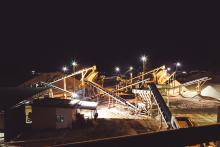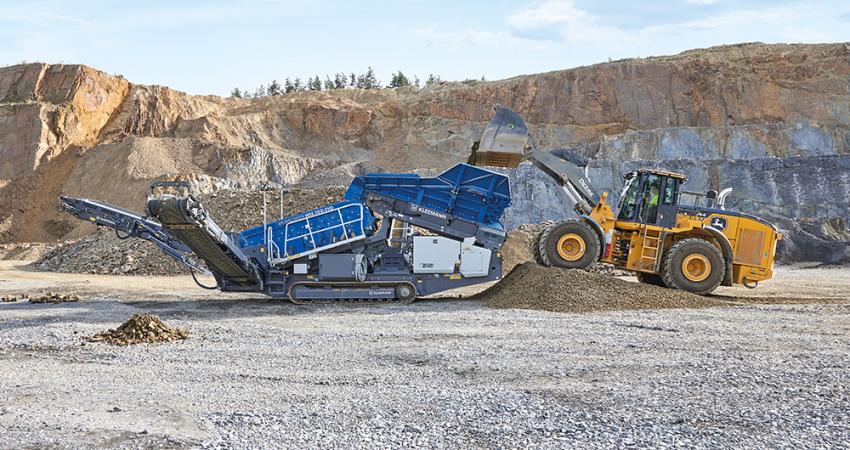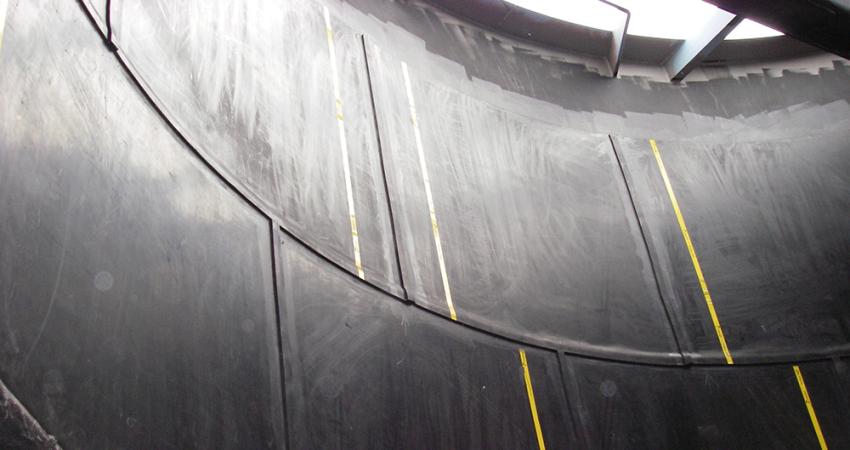
The Pachami crushing zone in eastern India is located 250km north of Kolkata, the capital city of the state of West Bengal.
A few years ago, it was a nondescript rock crushing area, with operators processing just a few tonnes of material each day, but now it is a vibrant zone where the latest technology is being employed to increase productivity.
This dynamic centre, in the Birbhum district of the state, meets much of the aggregates demand of West Bengal, which is currently seeing large-scale development of road infrastructure and real estate projects.
And if constraints over the stockpiling of aggregates at nearby railway sidings in Siuri and Pakur can be resolved, Pachami will become a major exporter of aggregates to neighbouring Bangladesh, where there is a massive demand for aggregates for that country’s ongoing railway and bridge projects.
Along with Pachami, the Birbhum district also has a number of other important crushing zones, including Talhand, Rampurhat, Nalhati, Rajgram, Salbhadra and Pakur, which borders West Bengal and the mineral-rich state of Jharkhand India.
Pakur is prominent in the production of railway ballast, operating plants of between 70-100tonnes/hour, but of all the crushing zones, Pachami is the largest and most active, with about 150,000 people being directly and indirectly involved in the industry.
There are nearly 300 commercial quarry owners at Pachami, operating plants producing between 70-100tonnes/hour, and more than 12 owners have technologically-advanced crushers capable of producing 200tonnes/hour.
They produce a total of 50,000tonnes aggregates/day from the quarries close to crushing sites, using drill and blast for the mainly basalt stone. This is followed by breaking with hydraulic breakers or jackhammers for further processing.
Regarding operational challenges, production at Pachami was 24 hours/day three years ago, but this has been reduced to between 8-12 hours/day due to problems with the local population in the last year.
The Pachami crushing zone has existed since the 1960s, and presents an interesting story of continuous and rapid evolution.
For example, medium to large quarries and crushing plant owners at Pachami used to own rotary screen plants that produced just 20-40tonnes/day, while primary breaking and loading of boulders into conventional fixed bodied trucks, featuring rudimentary technology, was done mainly using manual labour.
This continued throughout the 1960s-1990s, but from 2011 onwards quarry and crushing plant owners started upgrading their equipment to advanced 100-150tonnes/hour plants, and in 2012, buoyed by rising demand for aggregates in West Bengal, big plant owners at Pachami, saw further rapid transition, and acquired large numbers of 200tonnes/hour plants.
With the setting up of bigger capacity plants, owners went on to acquire advanced technologies for primary breaking, featuring jackhammers, surface drills, pneumatic compressors and hydraulic rock breakers for rocks of between 650-700mm. They also acquired advanced medium capacity excavators, wheeled loaders and multi-axle rigid dump trucks (RDTs) for loading and hauling.
A majority of the quarry and plant owners at Pachami have weighbridge infrastructure for trucks, and are commercial aggregates producers, usually operating fixed stationary type crushing plants that produce aggregates between 0-6mm; 12-16mm; 20-22mm, 40-60mm sizes.
Producers work on short- and long-term purchase contracts with contractors.
Pachami Stone Quarry (PSQ) was one of the earliest existing quarry and crushing plant owners in the zone to operate 25tonnes/hour plant in the 1960s.
It was the first to buy a 3tonne payload Indian Hindustan wheeled loader in 2011 to replace backhoe loaders, following an expansion of its plant size from 100tonnes/hour to 200tonnes/hour. It also acquired a new Atlas Copco surface drill and pneumatic compressor in early 2016.
“We brought one 200tonnes/hour each jaw, cone and four-deck screen from
A majority of the quarries at Pachami are below 45-61m from the surface, and RDTs operating in these quarries have box body configurations of between14-16m³.
PSQ has one
With plans to expand its capacity further, based on the growing demand for aggregates, PSQ will soon set up a 200tonnnes/hour plant, bought from Torsa Machines, an eastern India-based crushing and screening equipment manufacturer.
There is already one Torsa Machines’ plant at Pachami, a Torsa 3624. This 125tonnes/hour jaw crusher has a 91.44cm x 61cm feed opening; Torsa 166 three-deck screen, while the Korean cone, an MCC 1000 Minyu, is made available under a distribution tie-up with Torsa.
Tulu Mondal, proprietor of Mondal Stone Products, a major quarry and plant owner at Pachami, says: “To raise productivity by replacing our earlier jaw-jaw configuration plant, we set up one 200tonnes/hour Puzzolana jaw-cone, three-deck screen plant in 2014. To synchronise the entire production chain to attain higher production levels we bought five
“To back up our plants with commensurate higher feed volumes, a major acquisition was made by us for three Tata 2518 and nine Ashok Leyland 2523 RDTs in mid-2016 to transport boulders from our three 200feet [61m] deep quarries.”
Quarry and plant owners at Pachami are said to be aggressive in their efforts to acquire the latest equipment with advanced technologies, as many of them have major capacity expansion programmes, and this means newer and sizeable business opportunities for OEMs.
Indeed, the zone boasts almost all the major brands of equipment from Indian and foreign manufacturers, with big crushing plants from companies including Metso,
Almost 35 wheeled loaders with 3tonne payloads and 1.8m³ bucket are from brands including Hindustan,
About 160 pneumatic compressors are from manufacturers, including Chicago Pneumatic,
While Pachami is a big and attractive market, it is also challenging for OEMs to push sales, given the presence of highly demanding customers.
“Quarry owners here always place very strong pre-conditions on us to provide plants with complete assurance of high levels of consistent productivity and quality, so they can have quick returns on investments between seven to eight months post-commissioning of the plants. Moreover, they are paradoxically highly price-sensitive,” says Ashoktaru Chattopadhyay, vice president, Sandvik India.
“High levels of assured service back-up is another major demand from quarry owners at Pachami.”
Sandvik has five plants operating at Pachami, including a CJ 211 jaw crusher; CH 430 and CS 864 cone crushers, a PS 86 three-deck screen.
Annapurna Stone Quarry is another major plant owner at Pachami, having been there since 1978.
“It is the complete assurance to provide timely parts and service support by Metso India and the right pricing that made us go for their two plants of 200tonnes/hour each, consisting of a C 105 jaw and GP 11F cone, and C 106 jaw and GP 200 cone. The plants, though automated, are extremely easy to operate,” says Dilip Khemka, proprietor of Annapurna Stone Quarry.
“We were the first quarry operator at Pachami to use an advanced crushing plant from Metso in 2007. Very superior levels of maintenance and timely parts support enable us to produce 25,000tonnes of aggregates/month.”
He adds that it was the assurance of the local Man dealer offering timely product support, based on the company’s exacting hauling requirements, that made Annapurna clinch a deal to buy six 6x4 Man RDTs to transport boulders from quarry to crushing site.
Dutta Stone Quarry, which has been in the crushing business at Pachami since 1962, is one of the biggest aggregates producers at the crushing zone, processing between 30,000-36,000tonnes of crushed aggregates/ month with its Sandvik CJ 211 jaw; CH 430 cone, and two PS 86 three-deck screens. The plants are powered by a Caterpillar generator.
To achieve fuel savings, Dutta Stone Quarry acquired four new Bharat Benz 2528 RDTs in 2013.
“Based on the need to raise productivity in growing demand, we have always invested on newer technologies,” says Khokan Dutta, the second-generation owner of Dutta Stone Quarry.
“Prior to acquisition of the Sandvik plants we had secondary jaw and screen. These were assembled by us after sourcing parts from different local manufacturers.”
Dutta Stone Quarry, which brought one LM 100, Atlas Copco surface drill and an Atlas Copco XA 210 pneumatic compressor in 2006, is looking for newer quarries in the area as part of its business expansion plans.
Due to high demand, plant owners at Pachami must have adequate stockpiles, and this means running plants at optimum levels between December and June in order to avoid the heavy monsoon lashing eastern India from June to October, when quarry and plant operations are completely stalled at Pachami and adjoining zones.
With stiff competition among the owners they need to have higher profitability.
Based on these requirements, some plant owners at Pachami are now looking for even more advanced solutions, and one of them is Orbona Stone Quarry, the biggest aggregates producer at Pachami.
Producing between 46,000-56,000tonnes/month with a Sandvik CJ211 jaw crusher; CH 430 cone crusher, and two PS 86 screens, the quarry will soon be acquiring a vertical shaft impactor (VSI) from Sandvik to produce aggregates for road projects.
According to Prokasendu Sarkar, proprietor of Orbona Stone Quarry: “Higher productivity has been due to 10-15% more production from the Sandvik jaw crushers than the rated output. Other than this, it has been Sandvik’s design and commissioning support for setting up a 12m high stockpile conveyor at our crushing site. Initially, we were sceptical of the commercial viability of the engineering intervention owing to higher initial costs. However, the benefits have been numerous in terms of raising productivity and bringing down operation costs.
“Adequate stockpiles ensure constant feed to the cone crusher. This minimises wear and tear on the crusher which, if run without optimum feed, can damage the liners, creating higher, recurring expenditure.”
Hattagacha Black Stone is also looking for similar upgrades, as Mohammed Sohail, partner in the company, says: “We are looking for a cost-effective design and engineering solution to set up a high stockpile conveyor from Puzzolana Machinery Fabricators for our new second 200tonnes/hour plant to minimise our operations costs.”
Given the high demand of aggregates, there remains sufficient scope for crushing plant owners to raise productivity through the adoption of more advanced technologies.
However, there are numerous challenges confronting them as they seek to upgrade, including extremely narrow roads, which pass through tribal villages connecting the quarries to the crushing sites, making it arduous for RDTs to pass on either side. This has made owners hold back on decisions to acquire more, bigger bodied, technologically-advanced, multi-axle RDTs.
Frequent flooding of the quarries is also a major issue and can halt production. Among quarry owners there is also some apprehension following reports by the Indian government of the discovery of coal seams at Pachami.
However, owners say that concerns they may migrate to other zones are a “distant possibility.”









